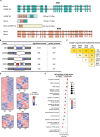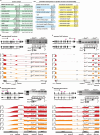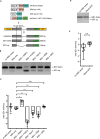Rbm3 deficiency leads to transcriptome-wide splicing alterations
- PMID: 39387568
- PMCID: PMC11575738
- DOI: 10.1080/15476286.2024.2413820
Rbm3 deficiency leads to transcriptome-wide splicing alterations
Abstract
Rbm3 (RNA-binding motif protein 3) is a stress responsive gene, which maintains cellular homeostasis and promotes survival upon various harmful cellular stimuli. Rbm3 protein shows conserved structural and molecular similarities to heterogeneous nuclear ribonucleoproteins (hnRNPs), which regulate all steps of the mRNA metabolism. Growing evidence is pointing towards a broader role of Rbm3 in various steps of gene expression. Here, we demonstrate that Rbm3 deficiency is linked to transcriptome-wide pre-mRNA splicing alterations, which can be reversed through Rbm3 co-expression from a cDNA. Using an MS2 tethering assay, we show that Rbm3 regulates splice site selection similar to other hnRNP proteins when recruited between two competing 5 splice sites. Furthermore, we show that the N-terminal part of Rbm3 encompassing the RNA recognition motif (RRM), is sufficient to elicit changes in splice site selection. On the basis of these findings, we propose a novel, undescribed function of Rbm3 in RNA splicing that contributes to the preservation of transcriptome integrity.
Keywords: RNA-seq; Rbm3; isoform switch; splicing; transcriptional fidelity.
Conflict of interest statement
No potential conflict of interest was reported by the authors.
Figures





Similar articles
-
Transcriptome protection by the expanded family of hnRNPs.RNA Biol. 2019 Feb;16(2):155-159. doi: 10.1080/15476286.2018.1564617. Epub 2019 Jan 6. RNA Biol. 2019. PMID: 30596342 Free PMC article. Review.
-
Heterogeneous nuclear ribonucleoprotein G regulates splice site selection by binding to CC(A/C)-rich regions in pre-mRNA.J Biol Chem. 2009 May 22;284(21):14303-15. doi: 10.1074/jbc.M901026200. Epub 2009 Mar 12. J Biol Chem. 2009. PMID: 19282290 Free PMC article.
-
A regulated PNUTS mRNA to lncRNA splice switch mediates EMT and tumour progression.Nat Cell Biol. 2017 Sep;19(9):1105-1115. doi: 10.1038/ncb3595. Epub 2017 Aug 21. Nat Cell Biol. 2017. PMID: 28825698 Free PMC article.
-
hnRNP proteins and splicing control.Adv Exp Med Biol. 2007;623:123-47. doi: 10.1007/978-0-387-77374-2_8. Adv Exp Med Biol. 2007. PMID: 18380344 Review.
-
Modulation of pre-mRNA structure by hnRNP proteins regulates alternative splicing of MALT1.Sci Adv. 2022 Aug 5;8(31):eabp9153. doi: 10.1126/sciadv.abp9153. Epub 2022 Aug 3. Sci Adv. 2022. PMID: 35921415 Free PMC article.
References
MeSH terms
Substances
Grants and funding
LinkOut - more resources
Full Text Sources
Other Literature Sources
